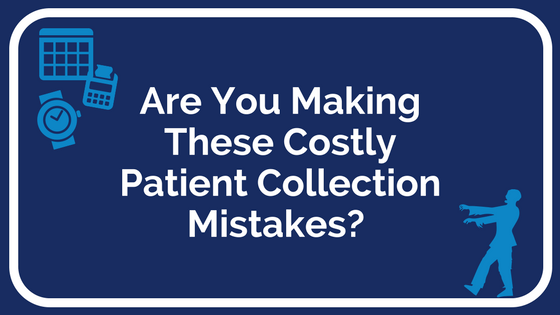RMP

It wouldn’t quite feel like the holidays without at least one “year in review” post to wrap up all that we have done in 2017. We dove into the archives to unearth all your favorite RMP Insights moments from this year and have created this countdown of the top 5 (plus) moments based on your engagement and feedback.
Top Webinar | Patient Collections 101: Concepts for Connecting Better & Collecting Better
What if you could get into the minds of your patients to understand what motivates them to pay (or not)? Now you can! In less than a hour you can get insights into what motivates patients to pay, the steps to follow for a successful collection call every time, and learn how to communicate more effectively for more comfortable patient conversations.
Download the Patient Collections 101 Webinar on Demand here
Top Resource | Collecting from Patients: An RMP Insights eBook
Patient responsibility now accounts for nearly one quarter of all revenue in the healthcare industry. Start collecting more of it! This eBook includes tips and best practices at each stage of the revenue cycle – from patient access to bad debt – for boosting receivables without sacrificing the patient experience.
Get your free copy of the Collecting from Patients eBook here
Top Blog Post | When Can I Send a Patient to Collections?
With so many regulations across the health care and debt collection industries in can be difficult to keep track of what your rights and requirements are as a creditor. Our FAQ article series has answered many of your most frequently asked questions, but none have been as frequent as “When can I send a patient to collections?”
Read “When Can I Send a Patient to Collections?” on the RMP Insights Blog here
Top Social Media Post | 2017 Sales Summit
Leave it to Sales & Marketing to break the internet. The new Meduit team came together for the first time for a few days in sunny Charlotte, NC for training, team building, and shenanigans.
Top Video | Stay Positive
At RMP we want to do our part to change the world, and we couldn’t do it without the help of our incredible team members. There are so many people in our organization who work every day to make the world a better place. One shining example is Eric Day, Business Development for RMP, and his Stay Positive foundation. Eric learned to stay positive through his battle with brain cancer, and now he raises money for others battling cancer by spreading the stay positive message. To learn more or to get your Stay Positive band, visit staypositivebands.org.
Top RMP Insights Moment | The Bloopers
We have one final chart-topping moment so great we had to add it to the list. You’ve seen the Stay Positive video, now take a peek behind the scenes at the year’s best bloopers. Many thanks to Eric Day and our Chief Sales Officer, Randy Tempest, for providing such golden comic relief.
The whole RMP family would like to thank you for another incredible year, we couldn’t do it without you. Be sure to stay tuned, we will be sharing some exciting news (and, of course, some great new content) in the new year and it’s starting to look like 2018 will be our best year yet!
Written by Ali Bechtel, Digital Marketing Manager
This information is not intended to be legal advice and may not be used as legal advice. Legal advice must be tailored to the specific circumstances of each case. Every effort has been made to assure this information is up-to-date as of the date of publication. It is not intended to be a full and exhaustive explanation of the law in any area, nor should it be used to replace the advice of your own legal counsel.

Human resources are the greatest advantage you have in an increasingly competitive market. For your healthcare organization to be successful it is equally as important to staff your team with great team members as it is to optimize your clinical and business processes. As we have built and developed our team with C.A.R.E., we have also identified 8 characteristics that you should be looking for within your existing staff, and when hiring new employees. Inspire these leadership principles in your staff and watch how quickly they help you reach your organizational goals.
No Excuses
“No excuses, no explanations.” – Tony Dungy
There are two kinds of people on every team: the ones who make excuses and the ones who get things done. Typically “excuse makers” already have an explanation in mind before they even begin a task, and entering into a commitment with that mindset gives them an excuse to fail before they even start. Making an excuse is a way to avoid failure, but great teammates (and great leaders) understand that failure is nothing but a learning opportunity unless it is allowed to become more than that. Solution-oriented people eliminate obstacles before they arise by asking questions.
Accountability
“Accountability breeds response-ability.” -Steven R. Covey
Those team members who do not make excuses will often also have a high level of accountability. It is important for the leaders in your organization to hold their staff accountable for their results and to provide frequent feedback about their performance. Accountability is not about scolding people for failing to meet their goals, but rather is about loving them enough to want to help them succeed. Encourage your team to have honest conversations about issues in their work. If it is important enough to be upset about it is important enough to talk about. (Otherwise, forget it!)
Servant Leadership
“People don’t care how much you know until they know how much you care.” – John Maxwell
One of the most important characteristics you can look for in your team members is servant leadership. Leaders should be there to serve their teams, and team members should be there to serve each other. After all, without internal support how can you possibly support a whole network of patients? Servant leadership requires building authentic relationships and giving your staff an opportunity to get to know each other. Only when they are serving each other, and holding each other accountable, will they really be committed to reaching shared goals.
Personal Example
“The most powerful leadership tool you have is your own personal example.” – John Wooden
Leadership that leads with a servant’s heart, and that is engaged, consistent, and genuine, is an example to the entire team of how they can serve others. You cannot expect a team to do more than its leaders are willing to, but it is important to remember that it isn’t just management who are viewed as leaders. Every department has those people who are looked to as an example. When everyone on your team is setting the right example, you can be sure that work ethic, integrity, and personal improvement will follow.
Passion
“Figure out what you are passionate about, enough to outwork everyone else it the world, because 90% of success in life is a direct result of how much effort you are willing to put forth. The trick is you have to be honest with yourself about what you are passionate about.” – Mark Schabel, CEO of RMP
It is unlikely that you will meet too many people who are passionate about collecting money from patients. Expecting your staff to love such a difficult task enough to want to be better than everyone else in the world is unrealistic. However, you can look for people who have identified what they are passionate about, and whose passion is in line with the goals and culture of your organization. That could be helping patients, or working together with their team. The best way to inspire passion in others is to help them honestly identify what they do love about their job and to embrace it.
Attitude
“The only disability in life is a negative attitude.” – Eric Day, Business Development for RMP, Founder of Stay Positive
Attitude is about how people choose to react to the world around them. Having a positive attitude requires sacrifice and a choice to rise of the circumstances. People who consistently make that choice are far more likely to act positively, and to set a positive example for others. To illustrate the importance of having the right attitude, consider this: only 1/3 of patients have indicated they would leave a practice due to service dissatisfaction to go to a competitor. The other 2/3 indicated they would leave as a result of the attitude or indifference of one employee.
Heart
“We don’t get burned out because of what we do. We get burned out because we forget why we do it.” – Jon Gordon
A heart-centered approach to business relies on the ability to look inward and reflect on goals and passions, and to understand why you are really doing what you are doing. Your team needs to have a firm understanding of why they are on the team; they need to feel valued, respected, listened to, and involved. If they are just there for a paycheck they will never be a great team member. But if they feel that they are valued and understand how they are part of the team they will have a better connection with their counterparts, and their leaders.
Belief
“Whether you think you can or think you can’t, you’re right.” – Henry Ford
Great teammates believe in themselves and in the rest of their team. They also need to believe in the mission and vision of your organization. This may be the hardest characteristic to determine, but if you are able to find passionate people who align with the goals of your team, who lead by example, and who have a positive and no-excuses attitude and show heart, then you have also found a person who will believe in themselves, and in you.
Want more tips for building a ridiculously successful team? Download our free team building webinar on demand!
Take this article with you! Click here for a printable version.
Written by Ali Bechtel, Digital Marketing Manager for RMP
This information is not intended to be legal advice and may not be used as legal advice. Legal advice must be tailored to the specific circumstances of each case. Every effort has been made to assure this information is up-to-date as of the date of publication. It is not intended to be a full and exhaustive explanation of the law in any area, nor should it be used to replace the advice of your own legal counsel.

Calling patients to request payment can be stressful and difficult, but it doesn’t have to be. Like every other touch point you have with a patient, the first and most important requirement for a successful patient collection call is to create a connection. If you approach a financial call with the same attitude as a registration or follow-up call you will set a positive tone for the conversation, and that can go a long way.
But that may be easier said than done when you are met with objections, excuses, or a refusal to pay. So we have also identified 8 easy to follow steps to get you through every call successfully:
1. Identify the Patient
The very first step of every call is to identify that you have the correct patient on the line. This step serves two very important purposes: preventing a HIPAA violation by providing PHI to the wrong party, and establishing a feeling for the call. Start by asking the right question:
“Hello, may I please speak with John Smith?” This is not the right question. Anyone familiar with John, and who he may want to talk to, won’t ask for him this way. This introduction is going to lead him to assume that this is a call he doesn’t want to answer, and so “John isn’t available at the moment.”
“Hi, John?…Hello Mr. Smith…” A simple greeting like “Hi, John?” will make him much more comfortable and more likely to continue the conversation. After he confirms his name, follow-up with his last name to ensure that you have the right person on the phone.
2. Identify Yourself & Your Employer
Once you have identified the patient, let them know where you are calling from. Remember: patients often will not recognize the corporate name for your healthcare organization, but they will remember their doctor’s name. It is important for the patient to recognize where the call is coming from right away. If they don’t know who you are and you start asking for money there is a good chance they will become defensive or confused, which is not likely to lead to payment. Try this:
“Hello, John?”
“Yes?”
“Hi Mr. Smith, this is Mary calling from Dr. Jones’ office at Respiratory Specialists. How are you today?”
3. Request Payment in Full and Offer Methods of Payment
Yes, you want to ask this question right away. Respect their time and get right to the point of your call, especially if they are impatient or indicate they are in a hurry. This part can be difficult, so use your judgment. Review their history to determine whether it might be better to lead into the request by following up on their latest appointment, confirming their demographic information, or asking for any secondary insurance before requesting the balance.
When you are ready to ask for payment, request the balance in full 100% of the time. Often you will not get it, but if you do you have just saved yourself four steps, and you can skip to step 8.
Asking how much they can “put toward” their balance indicates that they are not required to make a full payment. Instead, try asking: “How short of the balance are you today?” This question forces them to think about their entire balance and work down to what they can pay, rather than starting from zero and trying to work them up to an acceptable amount.
4. Psychological Pause
Once you have requested payment in full, give the patient a chance to respond. It is tempting to fill the awkward silence that follows such a request, but you need to give them a chance to agree to pay, or to offer their objection. It is easier to work with a patient when their objection is clear, so it is critical to allow them to give it.
5. Determine the Problem
This can be the hardest part. If the problem is simply that they cannot afford the total amount you know you need to attempt to arrange a payment plan. However, if they offer an objection or excuse for why they should not have to pay the bill, it is now your responsibility to determine the real root of the problem.
Objections about their care or their appointment that didn’t come up right at the time of service often mask other underlying issues, like confusion about their bill or their coverage. Working to the core of the issue and answering any questions the patient has will help them take responsibility for the bill.
6. Find the Solution
Once you have determined the real issue behind the patient’s inability or unwillingness to pay, work with them to establish a payment arrangement that addresses that problem. Make sure the arrangement is mutually agreeable; it should suit the patient but also be acceptable under your practice’s financial policy.
7. Close the Arrangement
Once a payment plan has been arranged confirm all the details with the patient, including the implications of failure to comply. Discuss the steps that will be taken in the event of nonpayment as they are outlined in your practice’s financial policy. Be sure to specifically provide all time limits and to fully explain any caveats or restrictions.
8. Update your Records
You made it! You’ve helped the patient to take responsibility for their bill, and secured payment or made an acceptable arrangement. All that is left is to record the details, including any reasons given by the patient regarding their inability to pay. These objections may come back up in the future and having detailed notes can help with future conversations.
Payment plans are only successful when they are enforced, so if your charge capture system has the ability, set a notification for the dates on which payments are due to ensure that the patient is adhering to the arrangement.
Putting these steps in place can help increase revenue while maintaining a good relationship with your patients. Collecting money does not have to be difficult, and the call can create an opportunity to connect. Taking the time to understand the patient’s situation and showing a willingness to work with them will improve their experience with your healthcare organization and will keep them coming back.
Want more tips for improving self-pay or self-pay after insurance balances? Download our free Patient Collections 101 Webinar on Demand!
Take this article with you! Click here for a printable version.
Written by Ali Bechtel, Digital Marketing Manager for RMP
This information is not intended to be legal advice and may not be used as legal advice. Legal advice must be tailored to the specific circumstances of each case. Every effort has been made to assure this information is up-to-date as of the date of publication. It is not intended to be a full and exhaustive explanation of the law in any area, nor should it be used to replace
the advice of your own legal counsel.

At church the other weekend, the sermon was a great one. It was about students being afraid to be “A” students because they didn’t want to be made fun of. It was slightly eye opening but seemed to make sense. At an age of such acceptance, being too smart or “nerdy” is a very touchy subject.
Imagine having this option on your first day of school: either sit at a table with ten of your new friends or sit in the corner with only one other person. It’s tempting to sit with ten friends, right? Now imagine the same scenario where the ten people at the table are being disciplined for bullying another student and the one student by himself is getting praised for sticking up for the bullied kid. Now which group do you want to be in? It’s tempting to fit in, but it isn’t always the right thing to do. The sermon stated that we are always doing God’s work no matter what we do (as long as not illegal or immoral) so lacking in school, especially on purpose, was lacking in our duty to God. Again, great message, it but got me thinking.
This doesn’t just apply to school. This applies to everyday life, and in particular, to work. Some people don’t want to “over achieve” or go the extra mile because they don’t want to be a “brown noser.” They don’t want others whispering – which is realistically out of jealousy or spite. To be the worker that goes the extra mile may feel great internally, but external pressure doesn’t allow us to be that person. I won’t go into this being the definition of America or the lazy workforce that inhabits many companies across America – but I will say this: No matter what you may believe, no matter who you may do it for, be the best.
If you’re doing God’s work, do the best work you’ve ever done. If you’re doing it for your company, do the right thing. And if you’re doing it for you – by all means do the best YOU can do. You are the only person who prevents you from achieving greatness – achieving the best. If you’re scared of being talked about at work, then you’re afraid to be the best. The best get criticized, the best get talked about both positively and negatively, and most importantly, the best take these negative things and turn them into something positive.
If you’re in the workforce long enough you’ll see great examples of both of these things. I’ve had managers who have backed down and expected less of themselves just to “fit in.” I’ve also seen people excel and do their best no matter what is being said about them. You have to decide which person you want to be. You have to make that choice. Sticking out in a large workforce could be the difference in your life. It doesn’t make you snooty. It doesn’t make you fake. It makes you a hard worker. It means you cherish what you do and you believe in what you stand for. It means you’re doing the best job that you can – whether it be for God, for your company, or simply for you.
I’ll leave you with a couple of my favorite quotes:
“If you’re the smartest person in the room, you’re in the wrong room.”
“To be successful in life, make yourself irreplaceable.”
Written by Luke Mauer, Senior Financial Analyst for RMP
Take this article with you! Click here for a printable version.
This information is not intended to be legal advice and may not be used as legal advice. Legal advice must be tailored to the specific circumstances of each case. Every effort has been made to assure this information is up-to-date as of the date of publication. It is not intended to be a full and exhaustive explanation of the law in any area, nor should it be used to replace the advice of your own legal counsel.

Price transparency is a critical element for ensuring not only a healthy revenue cycle, but also patient engagement and overall organizational success. With the spread of consumerism in healthcare, more patients are expecting pre-service estimates and a seamless billing and payment process. However there is one primary factor in that process that can be less than clear: insurance coverage.
As patients demand more information, particularly when it comes to financial responsibility, your front desk staff is going to have to answer more questions about benefits, eligibility, EOBs and coverage than ever before. While many medical office staff members have some training in this area, not all do.
In order to provide the best possible patient experience every person in your practice should have at least a basic understanding of the various types of insurance available, common terms, and what patients may be responsible for. After all, if they cannot explain to your patient why they owe money, the patient won’t be very motivated to pay it.
In this article we will overview the various types of responsibility and insurance plans your patients may have. We have also compiled a glossary of common terms. Get the printable list here.
Patient Responsibility
Each of these costs is part of the benefit package chosen by the patient, and is part of the agreement they entered into their carrier. It is important to remember that whether the patient is responsible for these costs, and for how much, will vary by plan.
Premium
The premium is the amount that must be paid for a health insurance plan. This could be paid entirely by the patient, by their employer, or the costs may be shared. Premiums are typically paid monthly, quarterly, or yearly. If the patient’s employer provides insurance and contributes to the premium, the patient’s portion of this responsibility is typically taken directly from their paycheck.
Deductible
The deductible is the amount owed by the patient for services before their plan begins to pay. For example, a patient with a $2,000 deductible will have to pay for all costs out-of-pocket until they reach $2,000, after which their plan will pay the majority (but usually not all) of their expenses for the remainder of their plan period. The deductible is renewed each year.
Some plans may pay for certain services before the patient has met their deductible, but that coverage varies by plan. Others may also incorporate a copay for certain services that can apply before the full deductible is met.
Deductibles have been getting a lot of attention lately as High Deductible Health Plans (HDHPs) become more commonplace due to rising costs. Most insurance plans that have high deductibles have lower premiums. It is very important to know whether a patient has met their deductible before providing services so that you can prepare them for the responsibility of up to 100% of the cost of the services you will be providing.
Coinsurance
Under most plans, patients are still responsible for sharing in the cost of care after they have met their deductible. The patient’s share of the cost, calculated as a percentage of the allowable amount, is their coinsurance. For example, if the coinsurance is 20% and the plan’s allowed amount for an office visit is $100, once the patient has met their deductible they are still be responsible for paying $20 for the office visit, and the plan will pay the rest. (Prior to meeting their deductible they would be responsible for the entire $100.)
Copayment
A copay is a fixed amount owed for a healthcare service, usually due at the time of service. It is technically a form of coinsurance but is defined differently, and must be paid before any policy benefits are payable by an insurance company. The amount can vary by provider and service, and can also be required for having a prescription filled.
Collecting copays from every patient at the time of service is not only critical to a practice’s financial success, it also affects reimbursement by insurance. To learn more about improving time of service collections, get our free Collecting from Patients eBook.
Maximum Benefits (or Capitation)
Insurance plans typically set a maximum amount they will pay in a plan year, known as maximum benefits or capitation. Once a patient reaches maximum benefits the insurance company will no longer pay for care, and the patient is responsible for 100% of the costs until their plan renews. Maximum benefits can be across coverage or for specific services. For example, a plan may have a maximum benefit of $6,000 for infertility treatments, and after reaching that limit the patient is responsible for costs associated with that care, while their plan may continue to cover other services for the remainder of the year.
Insurance Plans
What costs the patient is responsible for will vary based on plan type, as well as on an individual basis within each plan. While there is no formula for each and every patient will have to pay, being able to recognize the broad categories can help you determine what the patient may be responsible for, and can give cues for what to look for when running a verification and eligibility check pre-service. With so many to keep track of, we’ve made you a handy comparison guide.
Commercial Insurance
One of the most common forms of insurance is commercial, or private payer plans. These plans include major medical coverage, qualified health plans, and catastrophic plans as well as non-major medical coverage such as short-term and gap insurance. Commercial policies can be sold individually or as part of a group plan and are categorized according to renewal provisions and benefits provided. Patients coming to your office may have any one of these, or a combination of them. With various narrow networks within these different plans, it is critical to confirm that your provider is in-network before providing care.
Major Medical Plan Alphabet Soup
Under the Affordable Care Act (ACA), all medical plans must offer minimum essential coverage; certain services and treatments must be offered on all plans regardless of the carrier. However, there are several coverage formats available based on the patient’s lifestyle and health needs.
Health Maintenance Organization (HMO) Plans: Under these plans an entire network of providers agrees to offer its services, and a primary care provider coordinates all services and care. This is one of the most popular options and is best for patients who regularly visit their family physician, but they do come with the least freedom to choose providers. These plans typically require patients to pay a monthly premium, an annual deductible, and copays or coinsurance for each type of care.
Preferred Provider Organization (PPO) Plans: Under PPOs patients can generally see any provider in their network, including specialists, without a referral. Care is coordinated by the individual rather than a PCP. People who regularly visit specialists often prefer this type of insurance. These plans typically require patients to pay a monthly premium, an annual deductible, and copays or coinsurance for each type of care, as well as higher costs for out-of-network providers and sometimes higher allowable amounts.
Point of Service (POS) Plans: POS plans are a hybrid of HMOs and PPOs, so patients are required to coordinate care through a PCP, but also have the option to visit out-of-network providers if they choose, but will pay out-of-pocket to do so. These plans are a little more versatile but a little more costly, and are best for those patients who require a little more flexibility in their care. They typically require patients to pay a monthly premium, an annual deductible, and copays or coinsurance for each type of care; coinsurances and copays are higher for out-of-network providers.
High Deductible Health (HDHP) Plans: This format is quickly becoming one of the most common as costs continue to rise. These plans require patients to meet a high deductible, sometimes thousands of dollars, before any coverage takes effect. These plans are often coupled with health savings accounts (HSAs) and are the best option for people who want to save money and don’t plan to use their coverage much. These plans typically have a lower monthly premium as well as copays and coinsurance. Participants are encouraged to review their benefits carefully to learn what they will be responsible for before seeking care.
Non-Major Medical/Gap Plans
Short-Term Plans: For patients who miss open enrollment and need to start coverage mid-plan period, a short-term plan can hold them over with limited benefits as a safeguard against illness or accidents. This limited coverage does not meet the ACAs minimum essential coverage requirements, so they may come with a tax penalty and carriers may refuse coverage based on pre-existing conditions. These plans can provide coverage for any length of time from 30 days to 12 months and are nonrenewable.
Catastrophic Insurance Plans: These plans are designed to provide an emergency safety net for unexpected costs. They can stand alone or be coupled with another major medical plan in case of serious health issues. Similar to short-term plans, alone they do not meet the ACA’s standards and come with the same penalties and limitations.
Ancillary Dental and Vision Plans: Most major medical plans do not cover routine dental or vision care, and some patients or employers opt for additional coverage for these types of care. There are a wide array of options within these plans from discounted costs to full coverage.
Marketplace Insurance
The implementation of the ACA created the Health Insurance Exchange, or marketplace, where people without coverage can shop online for various types of insurance plans that meet the stringent requirements set forth by the Act. Each major medical format is available on the marketplace and is organized by “metal” category. These categories are based on how the patient and the plan share the costs of care.
Bronze: These plans generally have the lowest premiums and the highest deductibles and out-of-pocket costs. The insurance company pays 60% and the patient pays 40% in this category.
Silver: Patients who qualify for cost-sharing reductions based on their income may be able to select a silver plan, which has a lower premium as well as lower deductible and out-of-pocket costs. In this category the insurance company pays 70% and the patient pays 30%.
Gold: As the categories grow, the costs shift to higher premiums with lower deductibles, with more coverage provided by the insurance company and less patient responsibility. The insurance company pays 80% and the patient pays 20% in this category. Gold and platinum plans are less common due to their high monthly premiums.
Platinum: These have the highest premiums but the lowest deductibles. In this category the insurance company pays 90% and the patient pays 10%.
Government Insurance
In additional to commercial plans, there are also forms of government-assisted coverage. These services include Medicare, Medicaid, and Veteran’s Health Care.
Medicare Medicare is the federal health insurance program for people who are 65 or older (and is available to others in some cases) and is broken down into several parts. Coverage is based on federal and state laws, national coverage decisions by Medicare, and local decisions made by companies in each state that process claims for Medicare. Patients may have a single part or a combination, and determining what level of coverage they have is key to understanding their eligibility and benefits.
Part A: Hospital insurance that covers inpatient hospital stays, care in skilled nursing facilities, hospice and some home health care. Many people are eligible for premium-free Part A coverage, but in most cases those who have Part A also have Part B coverage and pay a monthly premium for both.
Part B: Medical insurance coverage for certain medically necessary services, outpatient care, medical supplies and preventative care. Patients pay monthly premiums for this coverage, but if they are receiving Social Security or other retirement payments the premium may be automatically deducted from their benefit payments. The current standard premium amount is $134.00 per month, but may be higher based on income.
Part C: Also known as Medicare Advantage Plans, these plans are offered by private companies that contract with Medicare to provide Part A and B benefits.
Part D: Adds prescription drug coverage from private insurance companies approved by Medicare to Original Medicare.
Medicaid A joint federal and state program that helps with medical costs for people with limited income and resources. Each state has different eligibility and patient responsibility requirements, and some people are eligible for both Medicare and Medicare. These “dual eligibles” often have most of their care covered, and there are specific processes for submitting claims to Medicare first, then to Medicaid, for reimbursement.
Veteran’s Health Administration The VHA is America’s largest integrated health care system and provides coverage to people who have served in active military service or are current or former members of the Reserves or National Guard who were called to active duty. Eligible veterans typically receive treatment at one of the 1,245 participating healthcare facilities nationwide, including 170 VA Medical Centers, but some care may be referred to private providers if the VA cannot provide the necessary care.
With so many plan types it can be hard to keep them all straight, so we’ve made you a handy comparison guide. Get it, the common terms glossary, and printable version of this article by clicking the button below!
Take this article with you! Click here for a printable version.
Written by Ali Bechtel, Digital Marketing Manager for RMP
This information is not intended to be legal advice and may not be used as legal advice. Legal advice must be tailored to the specific circumstances of each case. Every effort has been made to assure this information is up-to-date as of the date of publication. It is not intended to be a full and exhaustive explanation of the law in any area, nor should it be used to replace the advice of your own legal counsel.

When attempting to collect from patients it is easy to make simple mistakes that could cost your practice money. Financial conversations can be stressful, and in order to make it as comfortable for the patient as possible representatives may be too accommodating and make arrangements that do not benefit the practice in order to maintain the patient relationship.
However, there are ways to address the patient’s needs and secure acceptable payments for your practice. In this article and video series we share some of the most common patient collection mistakes you could be making, and simple tips for avoiding them.
The $10 Payment Trap
When establishing a payment arrangement it is very easy to fall into the $5 and $10 payment trap. When you ask a patient, “How much can you put toward this balance today?” you will inevitably hear $5, $10, maybe even nothing at all. When asked this question patients are often considering what they have available at that moment, after all of their other bills have been paid.
Instead, phrase the question this way: “How short of the balance are you today?” In our experience this question is often met with much higher commitments because it forces patients to consider their entire balance, rather than what they want to put toward it at that moment.
Long-Term Payment Arrangements
Once a patient has agreed to a monthly payment on their balance it is tempting to accept any amount they are willing to pay just to establish a consistent payment schedule. What representatives and patients alike do not consider when working out a payment amount is the length of the arrangement being established.
Consider this: accepting an arrangement of $10/month on a $500 balance is agreeing to give the patient more than 4 years to pay their bill. When you point this out to the patient even they will probably agree that it is an unreasonable arrangement. Keep a calculator by your desk in order to quickly calculate the length of an agreement before committing to it to ensure that you do not enter into a payment arrangement that is not beneficial for your practice.
Waiting Too Long to Begin Collection Calls
The chance of recovering your balance in full after the time of service decreases by 50% as soon as your patient walks out the door and the cost to collect only increases over time. According to the American Collector’s Association, the average recovery rate after 180 days – when most practices begin collection efforts – is only 13%.
One of the most common mistakes in patient collections is waiting too long to begin the process. This does not mean sending delinquency notices within a few days of service. There are simpler steps you can follow to help the patient prepare for their responsibility that can lead to higher recovery and a better patient experience. Provide an estimate prior to services being rendered whenever possible, and be sure to discuss responsibility before, during, and shortly after the time of service. Don’t miss the opportunity to collect more for your practice by waiting until after the patient’s appointment to begin a dialogue with them about their responsibility.
For tips and best practices for collection more at every stage of the revenue cycle, download our patient collections eBook!
Holding on to Past Due Accounts Too Long
The cost to collect from your patients does not only increase for your practice over time. The age of an account also affects the costs for your third-party medical collection agency. Most agencies will charge a higher fee on older accounts to compensate for the additional time and resources required to collect them. For optimum recovery we suggest sending your accounts no later than 120 days after delinquency.
Regardless of the age you choose, your practice should make a decision when to send delinquent accounts to your agency, share that timeline with patients in your financial policy, and strictly adhere to it. In addition to collecting more of your past-due balances, your patients will gain an understanding of your policies and procedures and may be timelier with future payments. Consistent reporting to your collection agency will also help to improve their recovery and lower your costs for a much healthier revenue cycle.
Want to keep this information handy? We made you a printable guide. Click here for your copy.
Take this article with you! Click here for a printable version.
Written by Ali Bechtel, Digital Marketing Manager for RMP
This information is not intended to be legal advice and may not be used as legal advice. Legal advice must be tailored to the specific circumstances of each case. Every effort has been made to assure this information is up-to-date as of the date of publication. It is not intended to be a full and exhaustive explanation of the law in any area, nor should it be used to replace the advice of your own legal counsel.

With so many regulations surrounding the collection of debt within the medical industry, it can be difficult to understand what your rights and requirements are as a creditor. One of the most frequently asked questions that we are asked is: When can I send a patient to collections?Continue Reading When Can I Send a Patient to Collections?
There is no denying that great leadership is the cornerstone of every successful organization. All of us have had managers: someone who is responsible for controlling our activities throughout the work day. Not all of us have had leaders.Continue Reading Are you Managing your Team, or Leading It?
Welcome to RMP Insights, we’re so happy you’re here! We would like to share a little bit about us and what you will find here, (hint: it’s all about helping you to become a revenue cycle rock star) and then we want to hear all about you.Continue Reading Welcome to RMP Insights!













